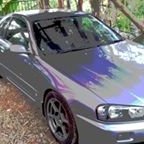Announcements
-
Similar Content
-
Latest Posts
-
some people are still around weirdly enough - most people just use facebook now to ask the same 12 questions tho XD
-
Omg Rezz! Yep we're still here and actually seeing a trickle of oldies coming back. How's things?
-
By GoHashiriya · Posted
So I raised the car up a fair bit for shipping - see image - then lowered it again when it arrived. I then rushed to get an alignment in NL before the track and the shop just wasn’t anywhere near as precise as what I got in Japan. The guys that did the alignment this week said there was a fair amount of toe in the rear that could have contributed to the understeer. It was also the case that the rear camber went from about -2 to -3 at the shop in NL. However, since I’ve now got slightly wider tires in the rear - NS2Rs run wider than Accelera 651S - I could only get a minimum of -3 in the rear now due to clearance. Front is now -2.75 (-2.45 in minutes) due to being raised a bit (previously -3 in JP). So it’s likely a combination of the two factors, camber and toe. The issue now is I have more camber in the rear than the front and the next step on the front Cusco arms will put me at -3.5ish front which seems a bit excessive to me. The weird thing is I’ve never had any understeer at the track in Japan but they are very different circuits - Japanese circuits are much slower than the one I’ve been to here. I’m probably going to have to start another thread for the E90. The plan is sort of to keep it as a daily but progressively mod it into a track car - honestly, you need a cage for the sort of speeds you go here. Just ordered the M3 front arms btw. Love the car despite it being in pretty shitty condition. Oil analysis came back okay and it seems to have stopped consuming oil since fixing a load of engine bay things. Saw yours is a 335i right? f**king mistake on my part getting the DI N53 over the N52, fuel economy is insanely good though at 14-16 km/L. Cheers, it’s great to see the benefits and pitfalls of different places. I’m contemplating going back to the U.K. around next year as the cost of living in the Netherlands is just ridiculous. GF is nagging me to settle and buy a house but I don’t know what LSD to buy. -
By LorelaiTorres · Posted
Have you seen the Milwaukee Train Horn? It's a beast! I stumbled upon it while browsing for upgrades. I'm thinking of adding it to my ride for some serious sound. Here's the link if you wanna check it out: https://bosshorn.com/products/milwaukee-train-horn. Anyway, thanks again for sharing your method. -
Anybody home...? I used to moderate this part of SAU about 20 years ago... hard to beleive it's still around basically unchanged with all the old posts pinned at the top. Amazing to read all those posts again. If anyone drops by, I'm still in Japan (Nishinomiya, between Osaka and Kobe). Cheers 🙂
-








Recommended Posts
Create an account or sign in to comment
You need to be a member in order to leave a comment
Create an account
Sign up for a new account in our community. It's easy!
Register a new accountSign in
Already have an account? Sign in here.
Sign In Now